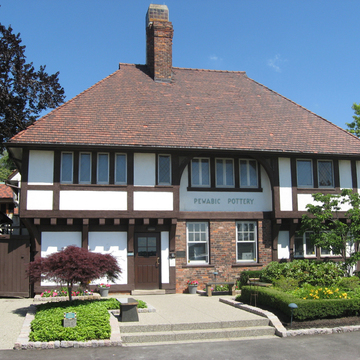Mary Chase Perry (1867–1961) founded the Pewabic Pottery Company in 1904 and named it after the Pewabic Copper Mine near her hometown of Hancock in the Upper Peninsula. In 1908 she moved her ceramic operation to its permanent studio, this English half-timbered cottage designed by prominent Detroit architect Stratton (1865–1938), whom she later married. The building harkens back to the English cottage both in its design, with the steep medieval roof, and in its function as a house for the small industry that became a central part of the Arts and Crafts movement in Detroit. In collaboration with Horace James Caulkins, a Detroit manufacturer of dental products, Perry systematically experimented with new firing techniques and chemical glazes in a revolutionary oil-burning kiln, which led her to the discovery of unique iridescent glazes. Architectural tiles fired by Mary Chase Perry Stratton in the kilns of Pewabic Pottery can be found in distinguished buildings throughout Michigan and the entire United States. Today Pewabic Pottery is a nonprofit ceramic education center. The Pottery is a National Historic Landmark.
You are here
Pewabic Pottery
If SAH Archipedia has been useful to you, please consider supporting it.
SAH Archipedia tells the story of the United States through its buildings, landscapes, and cities. This freely available resource empowers the public with authoritative knowledge that deepens their understanding and appreciation of the built environment. But the Society of Architectural Historians, which created SAH Archipedia with University of Virginia Press, needs your support to maintain the high-caliber research, writing, photography, cartography, editing, design, and programming that make SAH Archipedia a trusted online resource available to all who value the history of place, heritage tourism, and learning.















